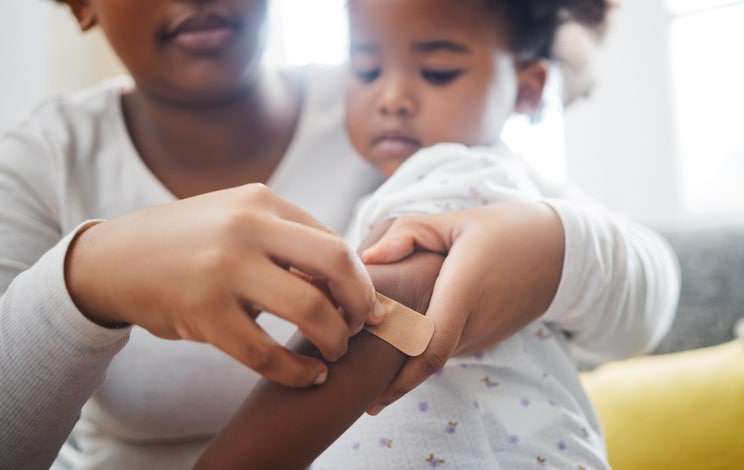In a perfect world, your child care job would be absent of emergencies and stress. While we can’t predict when they’re going to happen, there is some preparation babysitters can be equipped with for those unexpected incidents.
Your No. 1 priority in any emergency situation? Resolve the issue quickly while keeping the children safe and happy. Don’t let panic take over. Here are three possible situations you may face on the job and how can you handle them reasonably and responsibly.
Scenario #1: You’re locked out of the home without a phone
You’re late, really late. Stressed out and anxious, you stuff items into your bag, hustle out the door and drive to your babysitting job. When you arrive, you can’t seem to locate the keys to house. Hoping that there’s a spare key, you call the parent and let them know you are locked out but then you realize, you forgot your cell phone too. You don’t have time to drive back to your house, the school bus is going to pull up any minute. What do you do?
- Wait for the child: Bottom line, you are responsible for the child. Stay where you are and wait for them to get off the bus. Once the child with you, you can think about where to go and what to do.
- Go to the neighbors: If you’ve previously been introduced to a trusted neighbor, ask if you can use their phone to call the parent and alert them to the situation. Some families have a “hidden key,” and they may be able to tell you where it is so that you can get into the house.
- Consider other options: Part of your job is to make the parent’s job easier. First, consider your options. Then, discuss the options with the parent. If your home is nearby, you can drive the child to your house to retrieve the keys. Or, you can take the child to your house (or the library, a park, a museum, etc.) for the afternoon.
Things happen, keys go missing all the time. By proactively providing possible solutions to the parent, you are showing them you can resolve the issue. When they do come to pick up the child, apologize for your mistake and let them know you will be more careful next time.
Scenario #2: Injury on the playground
It’s a beautiful Friday afternoon, and you decided to take the children to the neighborhood playground. Both kids are happily running around and head to the swingset. You call out reminding the boy to use the swing the right way, but he doesn’t change his form. He loses his balance and scrapes his face against the rocks on the ground. You’re frustrated that he didn’t listen to your warning but more concerned about his injuries. What do you do?
- Don’t yell: As frustrated as you may be about his refusal to heed your advice, he needs help, not punishment. Besides, after this experience, he probably has learned his lesson.
- Seek assistance: While you check to see if he is OK, ask another parent to keep an eye on his sister. It may best if she’s occupied, so you can focus your attention on just him.
- Assess the injuries: If the cuts look really deep, he will most likely need stitches and will need to go to the emergency room. Remember: as a babysitter, you will need a medical release form if you go with the child to the hospital. If his skin is just scraped, grab your first-aid kit (a babysitter should always have one in their babysitting bag), sanitize your hands or put on a pair of plastic gloves. Once the bleeding is stopped, there’s an easy three-step, first-aid process:
- Clean the injury. Rinse with warm water (no soap). If there is any dirt or debris in the wound after you washed it, use tweezers (cleaned with alcohol) to remove the particles.
- Apply an antibiotic. Apply a thin layer of antibiotic ointment to help keep the surface moist. This will discourage infections in the wound.
- Cover the wound. Bandages can keep a wound clean and bacteria out. Once the wound has healed to a point where infection seems unlikely, remove the Band-Aid. Exposure to the air will speed up the healing process.
- Call the parents: It is important to inform the parents of what happened. Notifying them after the situation is taken care of will give them peace of mind that you are able and ready to handle difficult situations, including medical emergencies.
The unexpected injury is something most babysitters — and parents — will face. Kids will occasionally bump their heads, get a paper cut or fall off their bikes. Raising your voice or acting alarmed or scared will only frighten the children. It’s important that you stay focused, keep calm and work quickly to assess the situation and the kind of medical attention that is needed.
Learn the most common ways kids get injured — and how to prevent them.
Scenario #3: A child is missing
You take the children to the mall and walk into a toy store. You spot an old friend and begin chatting. When the conversation is over, you turn back around and one of the children is gone. Did she wander off? You frantically call out her name, but she is nowhere to be seen. What do you do?
People have difficulty thinking when they are under pressure or stress. “Children are easily distracted, running under clothing racks. Something will catch their eye and they will wander off,” says Officer Eddy Chrispin of the Boston Police Department. Try to remain calm. Take a minute to remember where you last saw her, what she was wearing. You may need this information to find her.
- Keep the other child close: You don’t want to have to look for two children. Keep the other child with you at all times (hold hands). Together you can call out for the lost child.
- Stay where you are: Don’t leave the store even if you suspect the child is roaming around. A child will come back to the last place she saw you. If you wander off and she returns, it will take longer to reunite.
- Get help: Alert the store manager immediately. Officer Chrispin advises, “Most children will hide under clothing racks so have the store employees do a thorough search of the store.” Have other shoppers in the store help you. Show them a photo of the child and give them a description of any identifiable features and clothing.
- Call a security guard: If she isn’t in the store, call a security guard who can help expand the search quickly.
- Make an announcement: Ask the security guard to make an announcement over the mall intercom to have the child return to the store.
Read more: Mom shares ultimate safety tip for finding missing kid in a crowded place
Do these steps first before you alert the parents. Time is critical and you need to focus on finding the child quickly. The child may be in the store or nearby. If the child has not been found with the help of mall security, do the following steps:
1. Call the police: “Usually mall security will call police if they need more assistance or if too much time has gone by,” says Officer Chrispin. “The reasonable amount of time depends on the age of the child. For younger children, you can take it upon yourself to call the police.” See if mall exits can be blocked off so that the child can’t wander outside of the mall.
2. Call the parents: This may be the hardest phone call to make, but inform the parents about the situation. Let them know the steps you have already taken and next steps you plan to take. Understand they may be upset and nervous, but by informing them you have alerted the authorities, they can take comfort in the fact that people are helping to find their child. Keep communicating with them and call them back once the child is found.
Losing track of a child is a babysitter’s worst fear. When the child is found, use this as a lesson to let her know that she shouldn’t wander off. Have the parents reiterate this lesson too. It may be a good idea to bring extra help (another babysitter, adult or friend) to help you supervise the kids during another outing.
Prevention is key. “Plant a message as early as possible,” suggests Officer Chrispin. “Anytime you go to a large area, let children know not to wander off. Tell them to stay close by. Remind them that if a stranger waves for them to come over to stay with you.” It is beneficial to reiterate this message whenever you take the children on an outing.






